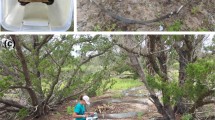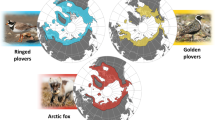Abstract
There has long been interest in the influence of predators on prey populations, although most predator–prey studies have focused on prey species that are targets of directed predator searching. Conversely, few have addressed depredation that occurs after incidental encounters with predators. We tested two predictions stemming from the hypothesis that nest predation on two sympatric freshwater turtle species whose nests are differentially prone to opportunistic detection—painted turtles (Chrysemys picta) and snapping turtles (Chelydra serpentina)—is incidental: (1) predation rates should be density independent, and (2) individual predators should not alter their foraging behavior after encountering nests. After monitoring nest survival and predator behavior following nest depredation over 2 years, we confirmed that predation by raccoons (Procyon lotor), the primary nest predators in our study area, matched both predictions. Furthermore, cryptic C. picta nests were victimized with lower frequency than more detectable C. serpentina nests, and nests of both species were more vulnerable in human-modified areas where opportunistic nest discovery is facilitated. Despite apparently being incidental, predation on nests of both species was intensive (57% for painted turtles, 84% for snapping turtles), and most depredations occurred within 1 day of nest establishment. By implication, predation need not be directed to affect prey demography, and factors influencing prey crypsis are drivers of the impact of incidental predation on prey. Our results also imply that efforts to conserve imperiled turtle populations in human-modified landscapes should include restoration of undisturbed conditions that are less likely to expose nests to incidental predators.




Similar content being viewed by others
References
Ackerman JT, Eadie JM, Yarris GS, Loughman DL, McLandress MR (2003) Cues for investment: nest desertion in response to partial clutch depredation in dabbling ducks. Anim Behav 66:871–883
Ackerman JT, Blackmer AL, Eadie JM (2004) Is predation on waterfowl nests density dependent?: tests at three spatial scales. Oikos 107:128–140
Anderson DR, Burnham KP, Thompson WL (2000) Null hypothesis testing: problems, prevalence, and an alternative. J Wildl Manag 64:912–923
Beasley JC, Rhodes OE Jr (2007) Effect of tooth removal on recaptures of raccoons. J Wildl Manag 71:266–270
Belsley DA, Kuh E, Welsch RE (1980) Regression diagnostics: identifying influential data and sources of collinearity. Wiley, New York
Bergin TM, Best LB, Freemark KE (1997) An experimental study of predation on artificial nests in roadsides adjacent to agricultural habitats in Iowa. Wilson Bull 109:437–448
Best LB (1978) Field sparrow reproductive success and nesting ecology. Auk 95:9–22
Bowen KD, Janzen FJ (2005) Rainfall and depredation of nests of the painted turtle, Chrysemys picta. J Herpetol 39:649–652
Browne CL (2003) The status of turtle populations in Point Pelee National Park. MSc thesis, Lakehead University, Canada
Browne CL, Hecnar SJ (2007) Species loss and shifting population structure of freshwater turtles despite habitat protection. Biol Conserv 138:421–429
Burger J (1977) Determinants of hatching success in diamondback terrapin, Malaclemys terrapin. Am Midl Nat 97:444–464
Burke VJ, Rathbun SL, Bodie JR, Gibbons JW (1998) Effect of density on predation rate for turtle nests in a complex landscape. Oikos 83:3–11
Burke RL, Schneider CM, Dolinger MT (2005) Cues used by raccoons to find turtle nests: effects of flags, human scent, and diamond-backed terrapin sign. J Herpetol 39:312–315
Butler JA, Broadhurst C, Green M, Zach Mullin (2004) Nesting, nest predation and hatchling emergence of the Carolina diamondback terrapin, Malaclemys terrapin centrata, in northeastern Florida. Am Midl Nat 152:145–155
Christens E, Bider JR (1987) Nesting activity and hatching success of the painted turtle (Chrysemys picta marginata) in southwestern Quebec. Herpetologica 43:55–65
Congdon JD, Gatten RE Jr (1989) Movements and energetics of nesting Chrysemys picta. Herpetologica 45:94–100
Congdon JD, Breitenbach GL, van Loben Sels RC, Tinkle DW (1987) Reproduction and nesting ecology of snapping turtles (Chelydra serpentina) in southeastern Michigan. Herpetologica 43:39–54
Congdon JD, Dunham AE, van Loben Sels RC (1993) Delayed sexual maturity and demographics of Blanding’s turtles (Emydoidea blandingii): implications for conservation and management of long-lived organisms. Conserv Biol 7:826–833
Congdon JD, Nagle RD, Kinney OM, van Lobrn Sels RC, Quinter T, Tinkle DW (2003) Testing hypotheses of aging in long-lived painted turtles (Chrysemys picta). Exp Gerontol 38:765–772
Doody JS, Sims RA, Georges A, Lannoo MJ (2003) Gregarious behavior of nesting turtles (Carettochelys insculpta) does not reduce nest predation risk. Copeia 4:894–898
Ellis JC, Shulman MJ, Jessop H, Suomala R, Morris SR, Seng V, Wagner M, Mach K (2007) Impact of raccoons on breeding success in large colonies of great black-beaked gulls and herring gulls. Waterbirds 30:375–383
Fleury AM, Brown RD (1997) A framework for the design of wildlife conservation corridors with specific application to southwestern Ontario. Landscape Urban Plan 37:163–186
Garber SD, Burger J (1995) A 20-year study documenting the relationship between turtle decline and human recreation. Ecol Appl 5:1151–1162
Gehrt SD, Hungerford LL, Hatten S (2001) Drug effects on recaptures of raccoons. Wildl Soc Bull 29:833–837
Hairston NG, Smith FE, Slobodkin LB (1960) Community structure, population control, and competition. Am Nat 94:421–425
Hammer DA (1969) Parameters of a marsh snapping turtle population, Lacreek Refuge, South Dakota. J Wildl Manag 33:995–1005
Hosmer DW, Lemeshow S (1999) Applied survival analysis: regression modeling of time to event data. Wiley, New York
Hougaard P (2000) Analysis of multivariate survival data. Springer, New York
Jenness J (2002) Nearest features with distances and bearings, version 3.6d. ArcView extension. http://arcscripts.esri.com (accessed 10 January 2006)
Kleinbaum DG, Kupper LL, Muller KE, Nizam A (1998) Applied regression analysis and other multivariate models. Duxbury Press, California
Klemens MW (2000) Turtle conservation. Smithsonian Institute Press, Washington DC
Kolbe JJ, Janzen FJ (2002) Spatial and temporal dynamics of turtle nest predation: edge effects. Oikos 99:538–544
Korpimäki E, Brown PR, Jacob J, Pech RP (2004) The puzzles of population cycles and outbreaks of small mammals solved? Bioscience 54:1071–1079
Laurance WF, Garesche J, Payne CW (1993) Avian nest predation in modified and natural habitats in tropical Queensland: an experimental study. Wildl Res 20:711–723
Legler JM (1954) Nesting habits of the western painted turtle, Chrysemys picta bellii (Gray). Herpetologica 10:137–144
Lindeman PV (1991) Survivorship of overwintering hatchling painted turtles, Chrysemys picta, in northern Idaho. Can Field-Nat 105:263–266
Llewellyn LM, Uhler FM (1952) The foods of fur animals of the Patuxent Research Refuge. Maryland Am Midl Nat 48:193–203
Marchand MN, Litvaitis JA (2004) Effects of landscape composition, habitat features, and nest distribution on predation rates of simulated turtle nests. Biol Conserv 117:243–251
Martin TE, Roper JJ (1988) Nest predation and nest-site selection of a western population of the hermit thrush. Condor 90:51–57
Marzluff JM, Gehlbach FR, Manuwal DA (1998) Urban environments: influences on avifauna and challenges for the avian conservationist. In: Marzluff JM, Sallabanks R (eds) Avian conservation: research and management. Island Press, Washington DC, pp 283–299
Murray DL (2006) On improving telemetry-based survival estimation. J Wildl Manag 70:1530–1543
Ontario Ministry of Natural Resources (2011) Species at risk in Ontario list. http://www.mnr.gov.on.ca/en/Business/Species/2ColumnSubPage/276722.html. Accessed 30 January 2011
Pelech SA, Smith JNM, Boutin S (2010) A predator’s perspective of nest predation: predation by red squirrels is learned, not incidental. Oikos 119:841–851
Petokas PJ, Alexander MM (1980) The nesting of Chelydra serpentina in northern New York. J Herpetol 14:239–244
Robinson C, Bider JR (1988) Nesting synchrony—a strategy to decrease predation of snapping turtle (Chelydra serpentina) nests. J Herpetol 22:470–473
Rowe JW, Coval KA, Dugan MR (2005) Nest placement, nest-site fidelity and nesting movements in Midland painted turtles (Chrysemys picta marginata) on Beaver Island. Michigan Am Midl Nat 154:383–397
Salo P, Banks PB, Dickman CR, Korpimäki E (2010) Predator manipulation experiments: impacts on populations of terrestrial vertebrate prey. Ecol Monogr 80:531–546
Schmidt KA (1999) Foraging theory as a conceptual framework for studying nest predation. Oikos 85:151–160
Schmidt KA (2004) Incidental predation, enemy-free space and the coexistence of incidental prey. Oikos 106:335–343
Schmidt KA, Ostfeld RS (2003) Mice in space: space use predicts the interaction between mice and songbirds. Ecology 84:3246–3283
Schmidt KA, Whelan CJ (1998) Predator-mediated interactions between and within guilds of nesting songbirds: experimental and observational evidence. Am Nat 152:393–402
Schmidt KA, Whelan CJ (1999) Nest predation on woodland songbirds: when is nest predation density-dependent? Oikos 87:65–74
Schmidt KA, Goheen JR, Naumann R (2001) Incidental nest predation in songbirds: behavioral indicators detect ecological scales and processes. Ecology 82:2937–2947
Sinclair ARE (1989) Population regulation in animals. In: Cherrett JM (ed) Ecological concepts: the contribution of ecology to an understanding of the natural world. Blackwell, Oxford, pp 197–241
Sinclair ARE, Pech RP, Dickman CR, Hik D, Mahon R, Newsome AE (1998) Predicting effects of predation on conservation of endangered prey. Conserv Biol 12:564–575
Snow JE (1982) Predation on painted turtle nests: nest survival as a function of nest age. Can J Zool 60:3290–3292
Strickland J, Colbert P, Janzen FJ (2010) Experimental analysis of effects of markers and habitat structure on predation of turtle nests. J Herpetol 44:467–470
Tinkle DW, Congdon JD, Rosen PC (1981) Nesting frequency and success: implications for the demography of painted turtles. Ecology 62:1426–1432
Vickery PD, Hunter ML, Wells JV Jr (1992) Evidence of incidental nest predation and its effects on nests of threatened grassland birds. Oikos 63:281–288
Vigallon SM, Marzluff JM (2005) Is nest predation by Steller’s jays (Cyanocitta stelleri) incidental or the result of a specialized search strategy? Auk 122:36–49
White GC, Burnham KP (1999) Program MARK: survival estimation from populations of marked animals. Bird Study 46:120–139
Wilhoft DC, Del Baglivo MG, Del Baglio MD (1979) Observations on mammalian predation of snapping turtle nests (Reptilia, Testudines, Chelydridae). J Herpetol 13:435–438
Wilson PR, Karl BJ, Toft RJ, Beggs JR, Taylor RH (1998) The role of introduced predators and competitors in the decline of kaka (Nestor meridionalis) populations in New Zealand. Biol Conserv 83:175–185
Yanes M, Suárez F (1996) Incidental nest predation and lark conservation in an Iberian semiarid shrubsteppe. Conserv Biol 10:881–887
Yerli S, Canbolat AF, Brown LJ, MacDonald DW (1997) Mesh grids protect loggerhead turtle Caretta caretta nests from red fox Vulpes vulpes predation. Biol Conserv 82:109–111
Zimmerman JL (1984) Nest predation and its relationship to habitat and nest density in dickcissels. Condor 86:68–72
Zoellick BW, Ulmschneider HM, Cade BS, Stanley AW (2004) Isolation of Snake River islands and mammalian predation of waterfowl nests. J Wildl Manag 68:650–662
Acknowledgments
We thank C. Huebert, A. Kidd, W. Smith, K. Libera, L. Swift, K. Hillman, K. Hillman, and H. Brown for field assistance; M. Allan, M. Gibson, and L. Foerster for field training and provisions; V. McKay, R. Donley, K. Scott, M. Stranak, D. Reive, G. Mouland, and T. Dobbie for project management; J. Bowman, C. Cullingham, B. Pond and E. Rees for input on statistical analyses; and J. Keitel and G. Harvey for map production. We also thank F. Janzen and two anonymous referees for insightful reviews of the paper. Funding for this project was provided by Parks Canada, Friends of Point Pelee, and the National Sciences and Engineering Research Council (NSERC).
Author information
Authors and Affiliations
Corresponding author
Additional information
Communicated by Joel Trexler.
Rights and permissions
About this article
Cite this article
Wirsing, A.J., Phillips, J.R., Obbard, M.E. et al. Incidental nest predation in freshwater turtles: inter- and intraspecific differences in vulnerability are explained by relative crypsis. Oecologia 168, 977–988 (2012). https://doi.org/10.1007/s00442-011-2158-y
Received:
Accepted:
Published:
Issue Date:
DOI: https://doi.org/10.1007/s00442-011-2158-y




